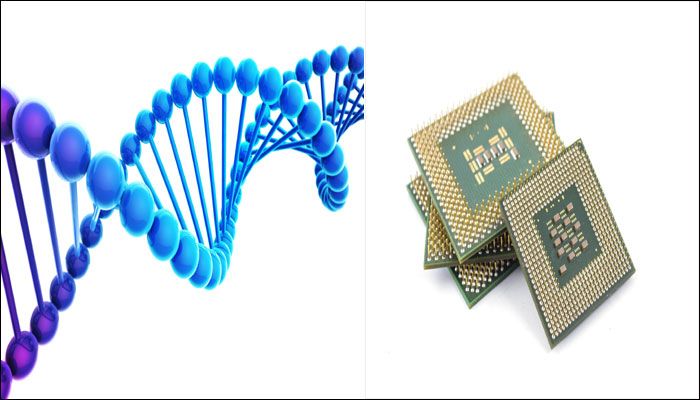Archive for the ‘nanotechnology’ category: Page 293
Mar 14, 2016
Get ready for DNA-based computer chips!
Posted by Karen Hurst in categories: chemistry, computing, electronics, materials, nanotechnology
Interesting — DNA Microchips to be released soon.
Researchers presented this incredible work at the national meeting and exposition of the American Chemical Society (ACS) in San Diego, California, on Sunday.
Adam T Woolley, professor of chemistry at Brigham Young University (BYU) said that they are planning to use DNA’s small size and base-pairing capabilities and ability to self-assemble, and direct it to make nanoscale structures that could be used for electronics.
Continue reading “Get ready for DNA-based computer chips!” »
Mar 14, 2016
‘DNA origami‘ paves way for faster, cheaper computer chips
Posted by Karen Hurst in categories: computing, electronics, nanotechnology
Scientists has opened a door to faster, cheaper computer chips with the help of ‘DNA origami.’ “We would like to use DNA’s very small size, base-pairing capabilities and ability to self-assemble, and direct it to make nanoscale structures that could be used for electronics,” Adam T. Woolley said.
Mar 14, 2016
Researchers create new triple helix structure for DNA — Many potential uses in chemistry, tissue engineering, etc
Posted by Shailesh Prasad in categories: biotech/medical, chemistry, engineering, nanotechnology
Could a cheap molecule used to disinfect swimming pools provide the key to creating a new form of DNA nanomaterials?
Cyanuric acid is commonly used to stabilize chlorine in backyard pools; it binds to free chlorine and releases it slowly in the water. But researchers at McGill University have now discovered that this same small, inexpensive molecule can also be used to coax DNA into forming a brand new structure: instead of forming the familiar double helix, DNA’s nucleobases — which normally form rungs in the DNA ladder — associate with cyanuric acid molecules to form a triple helix.
Mar 14, 2016
Nanotechnology is revolutionizing water filters
Posted by Shailesh Prasad in category: nanotechnology
Mar 14, 2016
World’s Thinnest Lens Could Revolutionize Nanotechnology
Posted by Karen Hurst in categories: biotech/medical, nanotechnology
Another great invention by the folks from Australia.
Researchers said they developed the new thinnest lens in the world. Made from a crystal called molybdenum disulphide, the new lens is 2,000 thinner than a human hair and can revolutionize the field of nanotechnology. (Photo : Gerd Altmann | Pixabay)
A team of Australian scientists said they have developed the thinnest lens in the world. The new 6.3-nanometer lens, which is 2,000 times thinner than a human hair, can lead to novel advances in medicine and science which could revolutionize nanotechnology.
Continue reading “World’s Thinnest Lens Could Revolutionize Nanotechnology” »
Mar 14, 2016
The ‘great smoky dragon’ of quantum physics
Posted by Karen Hurst in categories: nanotechnology, particle physics, quantum physics
Abstract: Since the 17th century, science was intrigued by the nature of light. Isaac Newton was certain that it consists of a stream of particles. His contemporary Christiaan Huygens, however, argued that light is a wave. Modern quantum physics says that both were right. Light can be observed both as particles and as waves — depending which characteristic is measured in an experiment, it presents itself more as one or the other. This so-called wave-particle dualism is one of the foundational principles of quantum physics. This questions our common sense: can one and the same indeed be of two contradictory natures at the same time?
Mar 12, 2016
Interesting Nanotechnology Animation 2
Posted by Shailesh Prasad in category: nanotechnology
Mar 11, 2016
Ray Kurzweil says nanobots will connect your neocortex to the cloud
Posted by Shailesh Prasad in categories: nanotechnology, neuroscience, Ray Kurzweil

Futurist Ray Kurzweil talks with StarTalk Radio’s Neil DeGrasse Tyson about the expansion of the human brain that he predicts will happen in the 2030’s.
Subscribe for more videos like this: http://bit.ly/1GpwawV
Continue reading “Ray Kurzweil says nanobots will connect your neocortex to the cloud” »
Mar 11, 2016
Digital CMOS Camera Series Boosts Quantum Efficiency (QE) For Breakthrough Photon Detection Capability
Posted by Karen Hurst in categories: chemistry, nanotechnology, quantum physics, security
Digital CMOS camera with QE technology with improved photon detection capabilities — now this should interest to many medical departments, researchers, and even for security checkpoint screening.
Hamamatsu Corporation has again raised the bar in scientific CMOS camera performance with the 2016 version of the ORCA-Flash4.0 V2. The increased quantum efficiency (QE), now at a peak of 82%, increases the likelihood of detecting the faintest of signals, helping to answer the question “Is it there?” And, for brighter samples, higher QE translates into shorter exposure times without sacrificing image quality. The ORCA-Flash4.0 V2 opens up new possibilities for imaging in low conditions and improves signal to noise at all light levels.
Since its introduction and evolution, the ORCA-Flash4.0 series has become the favorite scientific CMOS camera of investigators everywhere, powering cutting-edge imaging research in every field from biology and chemistry to astrophysics and nanotechnology. The widespread appeal is due to the vast array of high-performance features: low read noise, large field of view, high dynamic range and fast frame rates. The newly enhanced QE of the “Flash V2” only serves to increase the power and versatility of this game-changing camera.

















